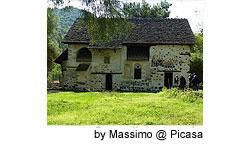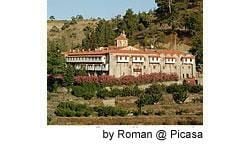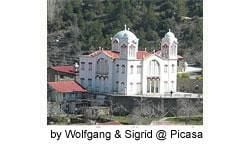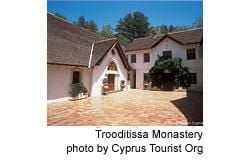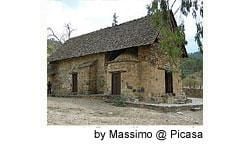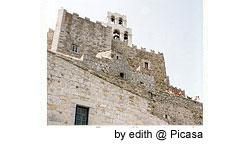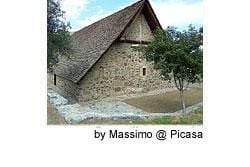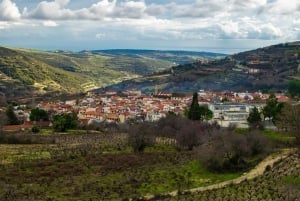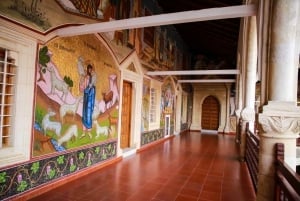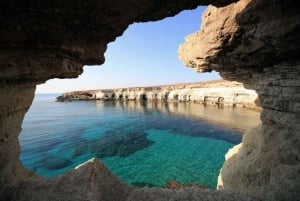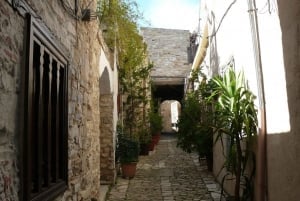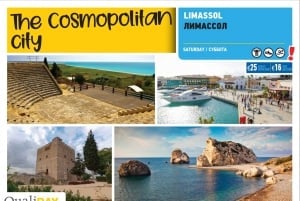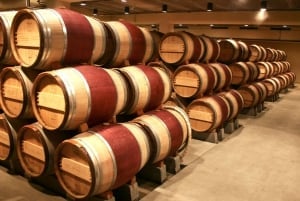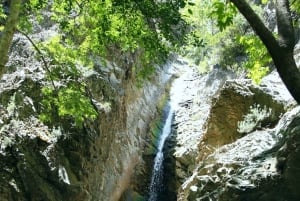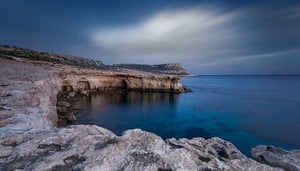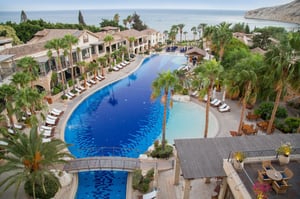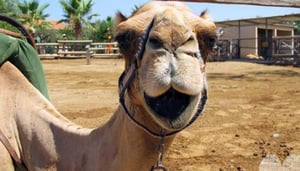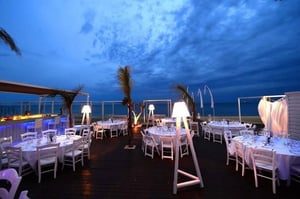Troodos Mountains Monasteries
Trooditissa Monastery
Trooditissa monastery is a beautiful monastery located 5km northwest of Platres village. The current structure of the monastery was built in 1731 and contains valuable icons including a silver gilded precious icon of Panagia (Holy Mary) from Asia Minor. A large religious fair is held every year on the ground of the monastery on August 15th to celebrate the Assumption of the Virgin Mary. Prayers to the holy icon of Panagia give hope to many couples wishing to have children.
Kykkos Monastery
Kykkos Monastery is the richest and most lavish monastery in Cyprus with religious, cultural and political importance. It is situated on a mountain peak, with magnificent views, at an altitude of 1318 metres northwest of Troodos. Dedicated to Panagia, it possesses an icon said to have been painted by Agios Loukas (Saint Lucas) the Evangelist. The icon is considered to be too sacred to look, thus, it is covered in silver-gilt on which it is embossed a representation of the icon itself. The icon is in a shrine made of tortoise shell and mother - of- pearl and stands in front of the iconostasis.
The monastery was founded sometime between the end of the 11th century and the beginning of the12th century, during the reign of Emperor Alexios I Komnenos (1081-1118 AD). Unfortunately, the original monastery burned down and nothing remains of the original structure. Blessed with divine grace, Cypriot hermit Isaiah miraculously cured the emperor's daughter of an incurable illness in exchange for the icon of the Theotokos (Virgin Mary) which was kept at the imperial palace in Constantinople.
The first President of the Republic of Cyprus, Archbishop Makarios III, served here as a novice. Following his wish he was buried on the summit of Throni, 3 kilometres west of the monastery, and not far from his native village of Panayia.
The monastery produces Zivania and a variety of other alcoholic drinks and holds religious fairs on September 8th (Birth of the Virgin) and August 15th (Dormition of the Virgin).
Address: West of Kalopanagiotis village, Troodos mountains
Tel: +357 22 942 736
Operating hours:
Daily: 10.00 - 18.00 (June - October)
Daily: 10.00 - 16.00 (November - May)
Operating Period: All year round
Entrance fee: Free (donations are welcomed)
Ayios Ioannis Lambadistis Monastery
Ayios Ioannis Lambadistis Monastery is one of the ten designated UNESCO World Heritage Sites in the area and is located just off the village of Kalopanagiotis. Originally a monastery, this complex consists of three churches – Agios Herakleidios, loannis Lampadistis and a Latin chapel, all of which even though were built at different times share a single enormous timber roof. The core monastery church, dated to the 11th century, is an arched cross-in-square structure. The Agios Ioannis Lampadistis chapel was built in the 12th century to the north of the first church and rested on the tomb of the Saint. The chapel collapsed later and was for its most part rebuilt in the 18th century. A new chapel was constructed to the north of that of Agios Ioannis during the second half of the 15th century. It later became known as the "Latin chapel" as it was believed to have been built for the Latins. Agios Herakleidios church has excellent 13th and 16th century frescoes and the most ancient wooden templon of Cyprus covered with heraldic-looking beasts such as the Lusignan lion and the Byzantine eagle, and with the arms of various Latin knights. The timbered roof that completely covers the roofs of all three churches and gives the complex its unique appearance was added at a later date. Adjacent the monastery of the same name is a museum that hosts rare and beautiful collection of Byzantine icons from local churches, with works dated from the 12th to the 16th centuries.
Accreditation: UNESCO World Heritage
Address: Kalopanagiotis village, Troodos mountains
Tel: +357 99 476 149
Operating hours: Tuesday - Sunday: 09.00 - 13.00, 16.00-18.00
Operating period: All year round
Entrance fee: Free (donations are welcomed)
Archangelos Micheal Church and Byzantine Museum
Archangelos Micheal Church and Byzantine Museum located in Pedoullas village is a small church that dates from 1474. The church is completely decorated on two levels, with 11 compositions from the Festival Cycle above and depictions of the saints below. The Crucifixion and the Ascension are depicted in the pediments. It is an example of local post - Byzantine painting 15 years before Venetian rule. The key can be found at the adjacent house, or leave a message for the village priest at the coffee shop.
Accreditation: UNESCO World Heritage
Address: Pedoulas village, Troodos mountains
Tel: +357 22 952 704 / +357 99 348 751
Operating hours:
Daily: 10.00 -18.00 (March - November)
Daily: 10.00 -16.00 (December - February)
Operating period: All year round
Entrance fee: Free (donations are welcomed)
Church of Agios Nikolaos tis Stegis ‘Saint Nicolas of the Roof’
The church of Agios Nikolaos tis Stegis ‘Saint Nicolas of the Roof’ is located near the village of Kakopetria. The church is completely painted with murals, with the most famous being the fresco of the Virgin Mary breastfeeding the baby Jesus, dating from the 11th to the 17th centuries and is considered one of the most interesting Byzantine churches on the island and boasts he most enchanting setting. Its name refers to the steep, pitched timber roof that was added in the 15th century to protect it from the heavy snowfall, setting the distinctive trend for Troodos chapels.
Accreditation: UNESCO World Heritage
Address: 3km from Kakopetria village, Troodos mountains
Tel: +357 99 484 423
Operating hours:
Tuesday - Saturday: 09.00 - 16.00
Sunday: 11.00 - 16.00
Monday: Closed
Operating Period: All year round
Entrance fee: Free (donations are welcomed)
Church of Panagia Asinou
The Church of Panagia Asinou is located in the village of Nikitari and overlooks a quiet valley. The famous Byzantine church of Asinou, a UNESCO World Heritage site, has some of the finest examples of Byzantine wall painting on the island. Asinou comes from the Greek Asine, which is an ancient city founded by immigrants from the Greek city Argolis in the 11th century BC. The church dates to the early 12th century and the murals inside date from the 12th century to the 17th century. Visitors should ask for the priest of Nikitari village to escort them.
Accreditation: UNESCO World Heritage
Address: Nikitari village, Troodos mountains
Tel: +357 22 852 922
Operating hours:
Daily: 09.30 -17.00 (May - August)
Daily: 09.30 -17.00 (May - August)
Daily: 09.30 -16.00 (November - April)
Operating period: All year round
Entrance fee: Free (donations are welcomed)
Church of Panagia tou Araka
Church of Panagia tou Araka is located just outside the village of Lagoudera. The church was founded in the 12th century and together with the Churches of Asinou and Agios Nikolaos tis stegis is considered to be the most important Byzantine churches on the island. The fresco is typical Comnenian style (1192) that is found in the churches of Greece and Russia. The church overlooks a valley, and is set among wild pea plants that gave the church its name.
Accreditation: UNESCO World Heritage
Address: Lagoudera village, Troodos mountains
Tel: +357 22 852 922
Operating hours: Daily: 09.00 - 18.00
Operating Period: All year round
Entrance fee: Free (donations are welcomed)
Machairas Monastery
Machairas Monastery is an active monastery. The monks are extremely devoted and committed, keeping vows as strict as those of Mount Athos in Greece. The monastery houses the miraculous icon of Panagia of Machairas said to have been painted by Apostolos Loukas. According to legend an unknown hermit brought the icon secretly from Asia Minor during the years of iconoclasm during the 8th to 9th century. The hermit leaved in a cave on the mountains of Machairas. The holy icon remained in hiding place cave long after the hermit’s death until around 1145 when blessed with a divine grace the hermits Neofytos and Ignatios reached the place and with the help of a knife given to them by a divine hand they cut their way into the cave which was by them completely covered with bushes. The icon took the name ‘Machairiotissa’ (meaning icon of Machaira, machairi in Greek means knife) and the monastery was erected in 1148 on the same site. The monastery has a rectangular layout . The supporting building and the monks’ cells are built around a centrally located church built in Byzantine architecture.
Another room is dedicated to the EOKA hero, Grigoris Afxentiou, who disguised himself as a monk and hid in the monastery while fighting for the Cyprus independence against the British rule. The hero was burned alive in his hide away, a kilometre away from the monastery, by the British in 1957 when he refused to surrender.
Address: Machairas, Troodos mountains
Tel: +357 22 359 334
Operating hours:
Monday - Friday: 08.30 - 17.30
Monday, Tuesday and Thursday: 09:00 - 12:00 (access for non-Orthodox visitors is restricted to groups only)
Operating Period: All year round
Entrance fee: Free (donations are welcomed)
No photo or video cameras are allowed within the monastery area


